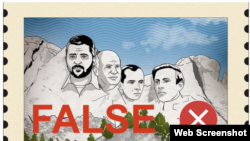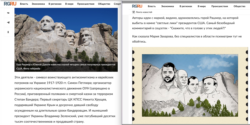July 28, 2002: This fact-check has been updated with information from Ukraine's postal service.
The claim that Ukraine’s postal service printed an antisemitic postage stamp trended in Russia media on July 19, including in the Russian government’s official newspaper, Rossiskaya Gazeta (RG).
Under the headline “Bandera, Petlyura, Zelenskyy and Khrushchev - a new stamp has been released in Ukraine.” the RG said the four men pictured on the stamp “played an important role in the country’s history.” It claimed the design was inspired by Mount Rushmore in the U.S.
"These figures are a symbol of militant anti-Semitism and Jewish pogroms in Ukraine in 1917-1920,” the RG wrote.
“Simon Petlyura; organizer of the Ukrainian nationalist movement OUN (banned in Russia), Stepan Bandera, sentenced to death by the Poles for terrorism; Nikita Khrushchev, First Secretary of the CPSU [Communist Party of the Soviet Union] Central Committee, who gave Ukraine Crimea and gave early release to Banderite convicts who had been sentenced to long terms. And the current president of Ukraine, Vladimir Zelenskyy, has already killed tens of thousands of compatriots and sold the country.”
This is propaganda on multiple levels, part of an ongoing strategy involving Russian state media, Russian embassies and Russian President Vladimir Putin and other leaders to exploit messy European history.
First, at a simple level, there is the supposed "stamp."
Ukrposhta, Ukraine’s postal service, currently has 36 postage stamp designs on its website. The “Mount Rushmore replica” with Zelenskyy and the others published by RG is not among them. Ukrposhta has also put its proposed stamp designs for 2022 online for public view. None resembles the stamp described by RG.
An earlier image of the "stamp" that circulated on Russian social media shows evidence of digital manipulation, based on analysis with the WeVerify/InVid software for identifying fakes. Results show the Mount Rushmore sketch appears to have been digitally inserted into another image.
A spokesperson for the Ukrainian Embassy in Washington, D.C., requesting anonymity to discuss unofficial information, said no such stamp exists. Update: On July 28, the Ukraine postal service confirmed to Polygraph.info that the stamp cited by RG is fake.
Second, Polygraph.info, academics and many other fact checkers have previously debunked Russia's branding of the Kyiv government as a fascist, "Nazi" regime. (Pointing out, for instance, that popularly elected Ukraine President Volodymy Zelenskyy is proudly Jewish and hardly a "militant anti-Semitic.")
Yale University historian Timothy Snyder, an acclaimed expert on fascism in Eastern Europe, has labeled this Kremlin approach "schizofascism" and attributes it to Putin. Writing for The New York Times in May, he said:
"Because Mr. Putin speaks of fascists as the enemy, we might find it hard to grasp that he could in fact be fascist. But in Russia’s war on Ukraine, “Nazi” just means “subhuman enemy”— someone Russians can kill.
"Hate speech directed at Ukrainians makes it easier to murder them, as we see in Bucha, Mariupol and every part of Ukraine that has been under Russian occupation ... Calling others fascists while being a fascist is the essential Putinist practice."
(Synder's 2018 book "The Road to Unfreedom: Russia, Europe, America" documents Putin's embrace of fascism and details the involvement of Russian figures in the 2014 annexation of Crimea and launch of war in Donbas.)
There is no doubt that antisemitism is part of Ukraine's history – but also of Russia's.
“Pogroms” were anti-Jewish mob attacks, often resulting in mass homicide, that took place frequently on the territory of the Russian Tsarist Empire. Some of the earliest pogroms occurred in 1821 in Odesa, with subsequent pogroms in that Black Sea port in 1821, 1859, 1871, 1881 and 1905. Another infamous pogrom took place in the city of Kishinev, in what is now Moldova, in 1903.
Pogroms also occurred between 1917 and 1921 – the years of the communist Bolshevik revolution and the Russian civil war. The Ukrainian People’s Republic (UPR) declared independence from Russia in 1918, and soldiers serving in the UPR army, which was fighting against the Bolsheviks, carried out pogroms. Ukrainian nationalists believed that Jews were allied with Russia’s communists, labeling them “Judeo-Bolsheviks.”
Symon Petlyura led Ukraine’s independent government during those years, first as a secretary of military affairs, then as the ataman, or head, of the Verkhovnaya Rada (Supreme Council). But broad-brushing Petlyura as a "symbol" of antisemitism oversimplifies his story, according to some who've looked more closely.
Christopher Gilley, a writer with the Open Democracy journalism project in London, researched the question of Petlyura’s personal responsibility in the pogroms and published a more nuanced review in February 2019:
“Was Petlyura a pogromist? He headed a government ostensibly committed to a multinational Ukraine, which had granted Jews the right to govern their own national-cultural life and created a Ministry of Jewish Affairs to represent them. In the first half of 1919, the UPR cabinet of ministers met after each atrocity to condemn the violence, call for severe punishments and demand an inquiry into the crime. The UPR government issued several public denunciations of the violence and created a special investigatory commission to bring perpetrators to justice…
"The pogroms were not UPR policy. They were outbursts of military indiscipline during which UPR troops and commanders, proceeding from the prejudice that Jews supported the UPR’s enemies, punished entire Jewish communities, brutally and without discrimination. Some perpetrators had only a very loose affiliation with the UPR.
"However, the view of Jews as hostile was not simply held by a few rogue units or irregular peasant partisans. Representatives of the UPR in powerful positions singled out Jews for special punishment. For example, the commandants of the cities of Dubno and Kremenets’ exacted a extraordinary tax from the local Jewish community as a punishments for its perceived disloyalty to the UPR.
"…The UPR leader certainly did not order anti-Jewish attacks. Even before his well-known condemnation of the violence in August 1919, Petlyura wrote several telegrams to local commanders calling on them to act against pogromists. However, Petlyura does seem to have accepted the idea that the Jews had brought the pogroms on themselves by failing to support the UPR.”
Stepan Bandera presents another polarizing case.
Bandera was a World War II-era Ukrainian activist of Polish origin who led the Organization of Ukrainian Nationalists, or OUN, which sought Ukraine’s independence from the Soviet Union. Bandera and fellow OUN members cooperated with Nazi Germany at the beginning of the war, envisioning their own fascist state.
OUN forces participated in pogroms carried out in conjunction with German SS forces in the summer of 1941, in what was then the Polish city of Lwow (now Lviv in Ukraine). According to one history:
“Once the SS’s murderous Einsatzgruppe turned up, the genocidal disorder became genocidal order and OUN militants took an active role. Over the course of 30 June to 2 July and then again from 25 to 29 July an estimated 8,500 to 9,000 Jews were killed in the city, which at that time had the third largest Jewish population in Poland. Bandera’s exact role in this barbarism is unclear, but as the leader of Ukrainian nationalist aspirations in a city where Ukrainian nationalists were running rampant, he had to have been aware, and it’s entirely possible he approved.”
Things turned sour for Bandera, as Deutsche Welle reported in a recent profile:
"Bandera was in occupied Poland when on June 30, 1941, his comrades proclaimed an independent Ukrainian state in Nazi-occupied Lviv — and the Germans banned him from traveling to Ukraine. Adolf Hitler rejected the idea of Ukrainian independence, and Bandera was arrested and imprisoned in Sachsenhausen concentration camp until 1944."
After WWII, Bandera lived in West Germany but remained involved in Ukraine’s independence movement. In 1959, while in Munich collaborating with West German's spy agency, he was assassinated with cyanide by a Soviet KGB intelligence agent.
Debate about Bandera’s OUN past and the mass killing of Poles and Jews during World War II remains heated to this day. Some Ukrainians revere him as a father of Ukraine independence. There are statues to Bandera; a postage stamp was issued for his 100th birthday in 2009; and supporters hold parades for him every year.
As such, Bandera's legacy adds complexity and vulnerability to a country at war.
"For most Russians, 'Banderovite' (often rendered as 'Banderite' in English) is still synonymous, as it was in Soviet rhetoric, with 'fascist thug' — so the celebration of Bandera feeds right into the 'Ukrainian Nazis' trope," writes Cathy Young, a Cultural Studies Fellow at the libertarian Cato Institute. "For many Ukrainians, it’s a much more complicated story."
The case of Soviet Cold War-era leader Khrushchev and Crimea may be less so.
Mark Kramer, director of the Cold War Studies Program at Harvard University, examined Khrushchev’s role in the 1954 transfer of the Crimean Peninsula from the Russian Soviet Federative Socialist Republic to the Ukrainian Federative Soviet Socialist Republic. The transfer was administrative, as both republics were part of the USSR.
Khrushchev, before becoming a top Communist Party official, had been the party leader in Kyiv. Kramer wrote:
“During the last several years of Khrushchev’s tenure in the UkrSSR, he had overseen the Soviet government’s side of a fierce civil war in the newly annexed western regions of Ukraine, especially Volynia and Galicia. The civil war was marked by high levels of casualties and gruesome atrocities on both sides. Despite Khrushchev’s later role in denouncing Stalinism and implementing reforms in the USSR, he had relied on ruthless, unstinting violence to establish and enforce Soviet control over western Ukraine.”
For Khrushchev, the transfer of Crimea was “a way of fortifying and perpetuating Soviet control over Ukraine,” Kramer wrote. It was also conditioned on the Ukrainian Republic’s resettling nearly a million ethnic Russians.
So according to RG, Khrushchev is now to be venerated on the Mount Rushmore of Ukraine?
Yevhen Fedchenko, founder of the Mohyla School of Journalism in Ukraine and co-founder of the StopFake fact-checking site, said the Ukrainian postal service "would not include Khrushchev among the politicians crucial for national independence."
Accusations of fascism and antisemitism distract from Russia's actual war, which has displaced millions from their homes, destroyed Ukrainian cities and killed civilians and soldiers in the 10s of thousands.
The propaganda also obscures Russia's own fascism. In his opinion piece for the Times, historian Synder writes:
"In the Russia of the 21st century, 'anti-fascism' simply became the right of a Russian leader to define national enemies. Actual Russian fascists, such as Aleksandr Dugin and Aleksandr Prokhanov, were given time in mass media. And Mr. Putin himself has drawn on the work of the interwar Russian fascist Ivan Ilyin. For the president, a “fascist” or a “Nazi” is simply someone who opposes him or his plan to destroy Ukraine. Ukrainians are “Nazis” because they do not accept that they are Russians and resist.
"A time traveler from the 1930s would have no difficulty identifying the Putin regime as fascist. The symbol Z, the rallies, the propaganda, the war as a cleansing act of violence and the death pits around Ukrainian towns make it all very plain. The war against Ukraine is not only a return to the traditional fascist battleground, but also a return to traditional fascist language and practice."






